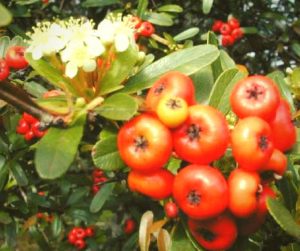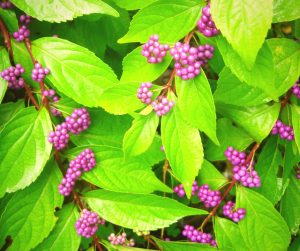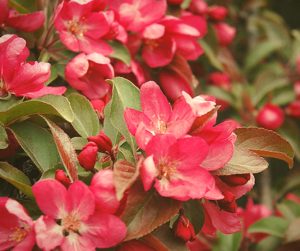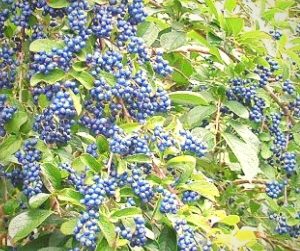The first (and sometimes only) berry plant that people associate with winter is the Holly berry bush. As beautiful and prickly as the Holly is, it’s not the only plant that produces brilliant red berries and colorful foliage to brighten the winter landscape. Incorporate some of these other five berry plants into the landscape for year around beauty, fall and winter color, natural bird food and for use in Christmas décor.
5 winter plants with berries for color in the snow
Firethorn (Pyracantha) – A Spectacular Evergreen Berry Plant
 Firethorn gets it’s name from the thousands of blazing red berries it produces and the needle like thorns which protect the berries. This spectacular evergreen berry plant is a rapid grower and will reach a height and width of 10 or more in just a few growing seasons. The rapid plant growth is easy to deal with since the firethorn loves to be pruned and is easily trained to grow in a hedge row or espaliered against a wall. Chose a disease resistant firethorn plant and plant it in full sun in well draining soil. Firethorn also comes in a variety that produces golden yellow berries.
Firethorn gets it’s name from the thousands of blazing red berries it produces and the needle like thorns which protect the berries. This spectacular evergreen berry plant is a rapid grower and will reach a height and width of 10 or more in just a few growing seasons. The rapid plant growth is easy to deal with since the firethorn loves to be pruned and is easily trained to grow in a hedge row or espaliered against a wall. Chose a disease resistant firethorn plant and plant it in full sun in well draining soil. Firethorn also comes in a variety that produces golden yellow berries.
Beautyberry (Callicarpa) is Aptly Named
 The beautyberry plant is not much of a looker for most of the year, but when fall arrives the berries put on quite a show. Beautyberry is a deciduous berry plant that produces massive amounts of purple, lilac and mauve colored berries that encircle the plant’s stem from top to bottom. Beautyberry comes in several varieties and sizes which range from tall growing (5 feet) to more compact growing berry plants.
The beautyberry plant is not much of a looker for most of the year, but when fall arrives the berries put on quite a show. Beautyberry is a deciduous berry plant that produces massive amounts of purple, lilac and mauve colored berries that encircle the plant’s stem from top to bottom. Beautyberry comes in several varieties and sizes which range from tall growing (5 feet) to more compact growing berry plants.
Flowering Crabapple (Malus) – Non-Edible Fruit
 Flowering crabapple will produce a mass of showy spring flowers followed by small bright red crabapples (non-edible) that will remain attached to the tree branches and gradually whither as the season changes into fall. Flowering crabapple will reach a mature height of between 15-25 feet. Chose a disease resistant variety and plant in full sun in well drained soil.
Flowering crabapple will produce a mass of showy spring flowers followed by small bright red crabapples (non-edible) that will remain attached to the tree branches and gradually whither as the season changes into fall. Flowering crabapple will reach a mature height of between 15-25 feet. Chose a disease resistant variety and plant in full sun in well drained soil.
Sapphireberry (Symplocos Paniculata) Produces Unusual Colored Berries
 The sapphireberry shrubs produces berries that are the most unusual of all winter berry plants. The berry color is sapphire, a deep blue-purple color that stands out from the red berry crowd. Sapphireberry is a large growing shrub that requires cross pollination to produce it’s jewel-toned berries in the late fall. Plant two sapphire berry plants in a sunny location in well draining soil.
The sapphireberry shrubs produces berries that are the most unusual of all winter berry plants. The berry color is sapphire, a deep blue-purple color that stands out from the red berry crowd. Sapphireberry is a large growing shrub that requires cross pollination to produce it’s jewel-toned berries in the late fall. Plant two sapphire berry plants in a sunny location in well draining soil.
Winterberry (Ilex Verticillata) – Only Female Plants Produce Berries

Winterberry is a large berry producing shrub (up to 10 feet) that will produce small green leaves during the spring and summer which will turn a brilliant yellow in the fall. It’s when the brilliant yellow fall foliage drops that the colorful red winterberries are revealed, shiny red berries that will last all winter.
Both male and female winterberry plants must be planted in close proximity to one another for the female winterberry to produce berries. Winterberry plants prefer a location in partial shade and thrive when planted near the edge of a pond, lake or other natural water source.
The post 5 Berry Plants to Brighten Winter Landscape appeared first on All around the house.
from All around the house http://allaroundthe.house/5-berry-plants-brighten-winter-landscape/
via IFTTT
Comments
Post a Comment